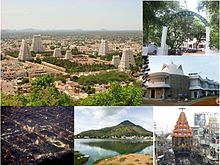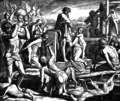The Cities Portal

A city is a human settlement of a notable size. The term "city" has different meanings around the world and in some places the settlement can be very small. Even where the term is limited to larger settlements, there is no universally agreed definition of the lower boundary for their size. In a more narrow sense, a city can be defined as a permanent and densely settled place with administratively defined boundaries whose members work primarily on non-agricultural tasks. Cities generally have extensive systems for housing, transportation, sanitation, utilities, land use, production of goods, and communication. Their density facilitates interaction between people, government organizations, and businesses, sometimes benefiting different parties in the process, such as improving the efficiency of goods and service distribution.
Historically, city dwellers have been a small proportion of humanity overall, but following two centuries of unprecedented and rapid urbanization, more than half of the world population now lives in cities, which has had profound consequences for global sustainability. Present-day cities usually form the core of larger metropolitan areas and urban areas—creating numerous commuters traveling toward city centres for employment, entertainment, and education. However, in a world of intensifying globalization, all cities are to varying degrees also connected globally beyond these regions. This increased influence means that cities also have significant influences on global issues, such as sustainable development, climate change, and global health. Because of these major influences on global issues, the international community has prioritized investment in sustainable cities through Sustainable Development Goal 11. Due to the efficiency of transportation and the smaller land consumption, dense cities hold the potential to have a smaller ecological footprint per inhabitant than more sparsely populated areas. Therefore, compact cities are often referred to as a crucial element in fighting climate change. However, this concentration can also have significant negative consequences, such as forming urban heat islands, concentrating pollution, and stressing water supplies and other resources. (Full article...)
Selected city -
Yerevan (UK: /ˌjɛrəˈvæn/, YERR-ə-VAN; US: /-ˈvɑːn/, -VAHN; Armenian: Երևան [jɛɾɛˈvɑn] ; sometimes spelled Erevan) is the capital and largest city of Armenia, as well as one of the world's oldest continuously inhabited cities. Situated along the Hrazdan River, Yerevan is the administrative, cultural, and industrial center of the country, as its primate city. It has been the capital since 1918, the fourteenth in the history of Armenia and the seventh located in or around the Ararat Plain. The city also serves as the seat of the Araratian Pontifical Diocese, which is the largest diocese of the Armenian Apostolic Church and one of the oldest dioceses in the world.
The history of Yerevan dates back to the 8th century BC, with the founding of the fortress of Erebuni in 782 BC by King Argishti I of Urartu at the western extreme of the Ararat Plain. Erebuni was "designed as a great administrative and religious centre, a fully royal capital." By the late ancient Armenian Kingdom, new capital cities were established and Yerevan declined in importance. The city was mostly depopulated by the Great Surgun of 1603–05, when the Safavid Empire forcibly deported hundreds of thousands of Armenians to Iran. In 1679, the city was mostly destroyed by an earthquake, and then rebuilt on a smaller scale. In 1828, Yerevan became part of the Russian Empire, which led to the repatriation of Armenians whose ancestors had been forcibly relocated in the 17th century. After World War I, Yerevan became the capital of the First Republic of Armenia as thousands of survivors of the Armenian genocide in the Ottoman Empire arrived in the area. The city expanded rapidly during the 20th century while Armenia was a part of the Soviet Union. In a few decades, Yerevan was transformed from a provincial town within the Russian Empire to Armenia's principal cultural, artistic, and industrial center, as well as becoming the seat of national government. (Full article...)Did you know -
- ... that the heiress Gertrude Rhinelander Waldo abandoned a brand-new mansion in New York City and refused to sell, rent, or maintain it?
- ... that until the opening of Altay railway station in June 2017, no railway services were provided to Altay City, a tourist attraction with rich mineral resources?
- ... that in 2006, half a million people used a temporary New York City public toilet sponsored by a toilet paper brand?
- ... that in the 1980s, New York City's St. Regis Hotel was said to have hosted every U.S. president since its opening?
- ... that during its planning stages, 53 West 53rd Street in New York City was shortened by 200 feet (61 m) to reduce the visibility of the mechanical rooms?
- ... that the 1978 New York City newspaper strike has been theorized to have caused great misery in Boston sports fans?
Related portals
Related WikiProjects
Tiruvannamalai (Tamil: Tiruvaṇṇāmalai IPA: ˈtiɾɯʋaɳːaːmalɛi̯, otherwise spelt Thiruvannamalai; Trinomali or Trinomalee on British records) is a city, a spiritual, cultural, economic hub and also the administrative headquarters of Tiruvannamalai District in the Indian state of Tamil Nadu. The city is home to the renowned Annamalaiyar temple, Annamalai hill, Girivalam and the Karthigai Deepam festival and a prominent pilgrimage destination.
Tiruvannamalai has a thriving service sector industry, including retail, resorts and recreation activities. Apart from the service sector, the city is also the hub for many industrial setups including SIDCO, spinning mills and premier educational institutions. The city is administered by the Tiruvanamalai City Municipal Corporation, originally constituted in the year 1886 as Tiruvannamalai Municipality. The city has a good network of roadways and railways connecting it with Chennai. The Union Ministry of Civil Aviation is considering setting up a new airport at Tiruvannamalai. (Full article...)Selected article -
The holiday of Mardi Gras is celebrated in southern Louisiana, including the city of New Orleans. Celebrations are concentrated for about two weeks before and through Shrove Tuesday, the day before Ash Wednesday (the start of lent in the Western Christian tradition). Mardi Gras is French for Fat Tuesday, the season is known as Carnival and begins on 12th Night, January 6th, and extends until midnight before Ash Wednesday. Club, or Krewe, balls start soon after, though most are extremely private, with their Kings and Queens coming from wealthy old families and their courts consisting of the season's debutantes. Most of the high society Krewes do not stage parades. As Fat Tuesday gets nearer, the parades start in earnest. Usually there is one major parade each day (weather permitting); many days have several large parades. The largest and most elaborate parades take place the last five days of the Mardi Gras season. In the final week, many events occur throughout New Orleans and surrounding communities, including parades and balls (some of them masquerade balls).
The parades in New Orleans are organized by social clubs known as krewes; most follow the same parade schedule and route each year. The earliest-established krewes were the Mistick Krewe of Comus, the earliest, Rex, the Knights of Momus and the Krewe of Proteus. Several modern "super krewes" are well known for holding large parades and events (often featuring celebrity guests), such as the Krewe of Endymion, the Krewe of Bacchus, as well as the Zulu Social Aid & Pleasure Club—a predominantly African American krewe. Float riders traditionally toss throws into the crowds. The most common throws are strings of colorful plastic beads, doubloons, decorated plastic "throw cups", and small inexpensive toys. Major krewes follow the same parade schedule and route each year. (Full article...)General images -
Topics
List articles
Subcategories
Associated Wikimedia
The following Wikimedia Foundation sister projects provide more on this subject:
-
Commons
Free media repository -
Wikibooks
Free textbooks and manuals -
Wikidata
Free knowledge base -
Wikinews
Free-content news -
Wikiquote
Collection of quotations -
Wikisource
Free-content library -
Wikiversity
Free learning tools -
Wiktionary
Dictionary and thesaurus









































